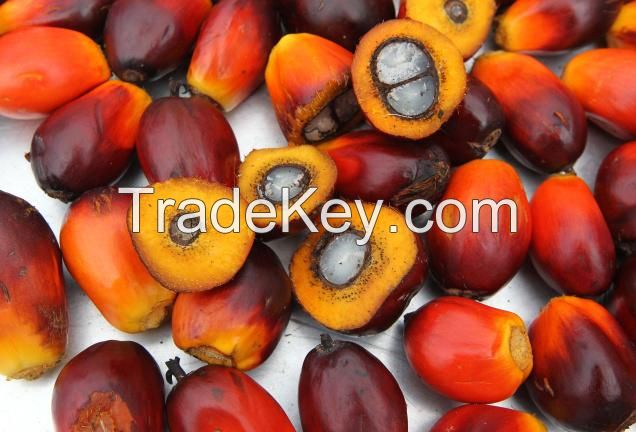We have palm nuts and you can contact us for quantity that you
want.
The fruit of the oil palm tree (Elaeis guineensis Jacq.) has a thin
epicarp, a fleshy and oily mesocarp and a hard endocarp that
contains an oil-rich endosperm (kernel) (Vaughan et al., 2009).
Palm oil is extracted from the mesocarp. In a second step, the nut
is cracked to release the endosperm (kernel). Theses kernels are
usually sent to another processing unit to be pressed or treated
with a solvent to extract palm kernel oil, an oil rich in lauric
acid (44-51%) (Gervajio, 2005) but they are sometimes fed directly
to livestock for their high energy content.
Distribution
Oil palm kernels are available in the vicinity of oil palm
processing units.
Processes
Palm kernels are hard and should be crushed before being fed to
livestock (Vargas et al., 2003).
Nutritional attributes
Oil palm kernels contain about 46-54% DM of oil and have therefore
a high gross energy content (28.9 MJ/kg DM) which make them
valuable as a potential replacement for high-energy ingredients.
However, they are contaminated with variable amounts of a fibrous
and lignified endocarp (3-13%) and contain between 12 and 15% DM of
crude fibre (Zumbado et al., 1996). They are also relatively poor
in protein (about 10% DM).
Tables of chemical composition and nutritional value
Oil palm kernels
Ruminants
In dual purpose grazing cows fed 1 kg/d of a supplement containing
0 to 33% of palm kernels, the inclusion rate of 25% gave the best
dairy performance and was also the most profitable. While calf
growth did not benefit from the kernels, the cows fed palm kernel
gained weight unlike those fed the control diet (Rojas et al.,
1987).
Poultry
Broilers
Palm kernels were found to be a valuable alternative ingredient for
increasing the metabolizable energy levels of broiler diets based
on soybean meal, maize grain or sorghum. However, results are
contradictory. The inclusion of more than 5% palm kernels in
broiler diets reduced growth and feed intake, and increased feed to
gain ratio (Oruwari et al., 1996). In Costa-Rica, palm kernels
could be included up to 20% in broiler diets to increase energy or
replace tallow and soybean oil, though performance decrased when
they substituted for more than 50% of soybean oil (Zumbado et al.,
1992). When included at 20% in broiler diets, variations in
endocarp content (from 0 to 15%) did not affect significantly
broiler performance (Jackson et al., 1996).
Laying hens
In laying hens, palm kernels were found to be a useful alternative
to maize grain when this ingredient was scarce and kernel prices
were low. Palm kernels could replace up to 33% of the maize grain
in the diet without influencing significantly feed intake, average
egg weight, hen-day production, body weight gain, protein and fibre
retention though fat retention was affected (Adekoya et al.,
2004).
Energy values
The energy value or palm kernels is high: TMEn value range from
18.8-20.0 MJ/kg DM (cockerels, Zumbado et al., 1996) to 25.5-25.6
MJ (broilers and laying hens respectively, Oruwari et al., 1996).
Contamination with pericarp residues influences the nutritional
value of palm kernels: TMEn values decreased from 20.0 to 18.8
MJ/kg DM when the amount of endocarp increased from 0 to 12%
(Zumbado et al., 1996).
Feed categories
Oil plants and by-products
Plant products and by-product


